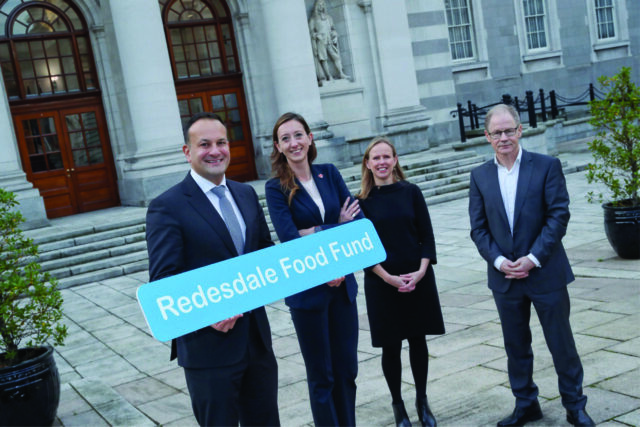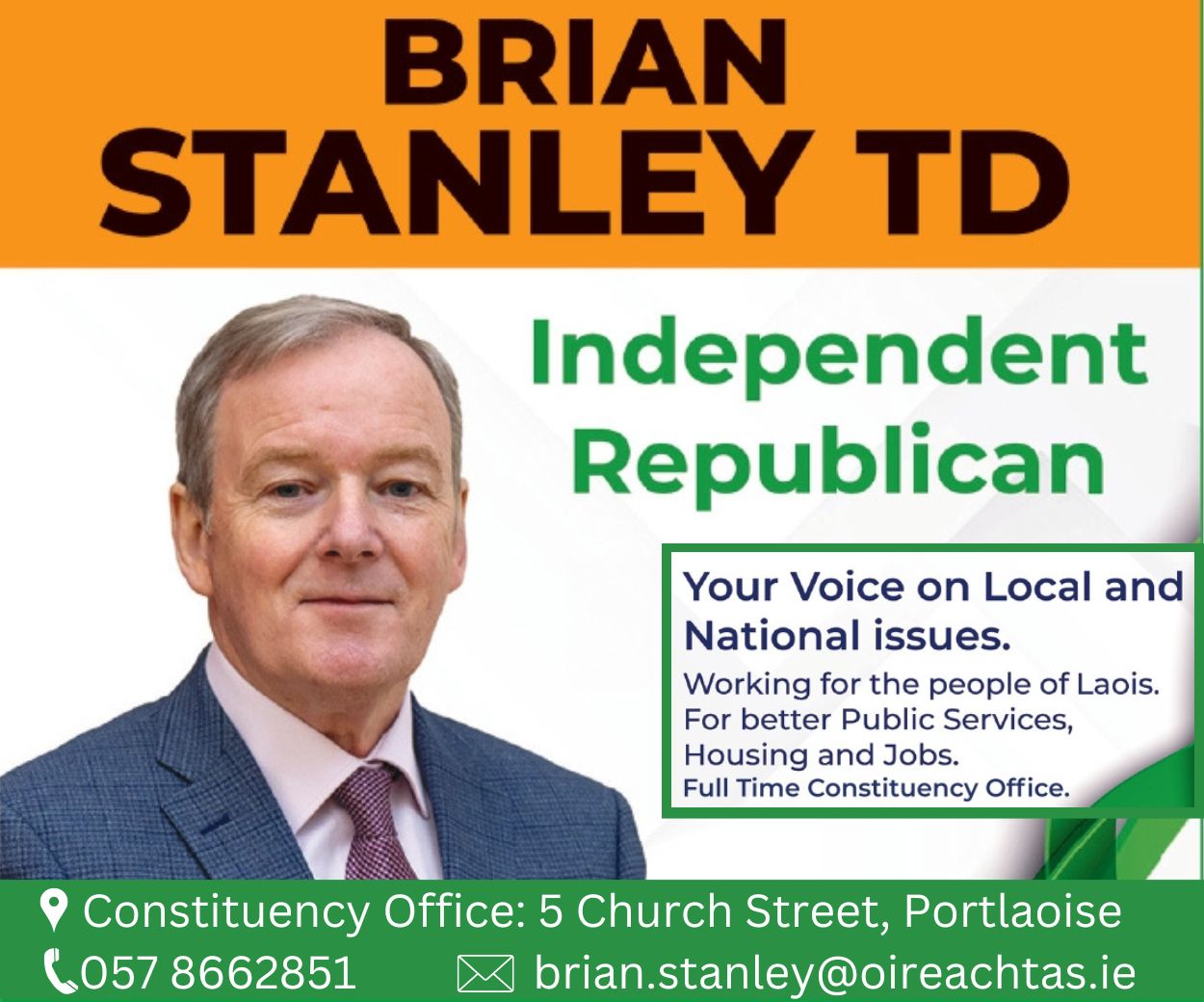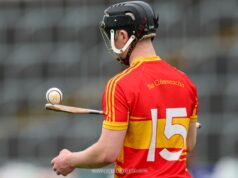
Cutting deals in both good and bad economic times, Portlaoise born financier Seán (John) Conroy has been at the heart of the action in boardrooms around the globe.
In this second part of our interview, we asked him about some of the most memorable of those deals as well as his take on the issue of female representation in business.
Laois connections can spring up in the unlikeliest of places as Seán discovered when he first met Eddie Jordan in his early days in NCB Stockbrokers, with the Formula One Supremo proudly letting the Portlaoise man know that his mother hailed from Stradbally.
“Sport is big business and, the World Cup and Olympics aside, they don’t come any bigger than Formula One.
“The annual budget to run an F1 team is at least €100m and so the teams tend to be owned or backed by large corporations. Jordan Grand Prix was an anomaly,” said Seán who is based in Dublin.
“Owned and managed by Eddie Jordan and against all the odds, the team became a competitive force on the Grand Prix circuit in the late 1990s and had a maiden win at the Belgian Grand Prix in 1998.
“The victory that day, in a crazy race in rain sodden Spa Francorchamps, with Damon Hill at the wheel, must surely go down as one of the great moments in Irish sport,” he said.
“But it was hand to mouth stuff. Each year, Jordan would start out with virtually a blank sheet in funding and had to rely on winning a large number of relatively small sponsorship deals.
“That the team managed to get through one season, never mind a decade in Formula One, was testimony to the persuasive powers of ‘EJ’ as he was known, probably the best salesperson I have ever met.
“But he was more than that. He was a true entrepreneur in building an international business and it didn’t surprise me that he won the EY World Entrepreneur of the Year award for global leadership in 2001 in Monte Carlo.
“I had known Eddie since the late 1980s when he used to drop in to NCB to meet Dermot Desmond. As probably the only F1 enthusiast in the company at the time, I found myself as one of his relationship managers. The fact that his mother hailed from Laois may have helped.
“When I left NCB and set up Merrion, we remained in contact. One of our advisory board members at the time was Eamonn Coghlan, world champion at 5,000m.
“So, there you had it: a world champion athlete, a Formula One winner and the proud holder of an U-14 Portlaoise street league hurling medal. Incidentally, Eamonn and Eddie are cousins,” quipped Sean.
The 2005 sale of the Jordan Grand Prix F1 team was not the biggest deal Merrion did.
“That accolade went to the take-private of Jefferson Smurfit. However, it was probably the most fun. The deal was really a two-part transaction.
“We first bought the 50 per cent of the company which was owned at that time by a London-based private equity group and then sold the entire company sometime later to Midland Group.
“The team has since undergone a few ownership and name changes including to Force India and now Aston Martin. It was an eye opener.
“I thought I knew a lot about F1 but I discovered whole new ways of doing business in a world controlled by the ultimate ringmaster of the day, Bernie Ecclestone,” said Seán. His niece Lola, has now taken over as the resident Conroy family expert on F1.
Most important deal
“I suppose the most important deal for me personally was to bring in Allen & Co Inc as a strategic investor when we set up Merrion Capital in 2000. The last thing Ireland needed at that stage was another ‘same type’ stockbroker, so we had to be different,” he said.
“The best way of convincing the market, we felt, was to bring a high quality independent-minded partner on board. Enter Allen & Co Inc. The famed US investment bank, family-owned with origins tracing back to 1929, is notoriously private.
“Now regarded as the foremost media investment bank in the world, it is probably best known over here for its annual Sun Valley conference, a Davos with teeth, which attracts the most influential players in the business world – the likes of Tim Cooke, Bill Gates, Warren Buffet, Mark Zuckerberg, Bob Iger and so on, a true power player,” said Seán.
“As a start-up in a tiny Irish market, we had no business whatsoever having Allen & Co on our share register.
“But in the group I hung around with in Portlaoise, our dictum was: ‘If you’re going to get refused, it might as well be by the best looking woman on the dance floor.’ We got a great many ‘nos’ and a few ‘no thanks,” he laughed.
The introduction to Allen came via the Smurfit Group. “They ended up taking a 30 per cent stake and we were privileged to have been their only true investment in the financial services industry and the only non-US investment.
“They conferred immediate credibility on us and paved the way for regulatory approval and successful launch,” Seán said.
“Allen weren’t the sort of people who clapped you on the back for doing well in good times but they were in your corner in difficult times.
“And difficult times we had, at the start In particular. We launched at the beginning of 2000; within ten weeks, the internet bubble had burst and the Nasdaq went into free fall.
“Then we had a tsunami of negative events: the major scandals in Worldcom and Enron, the 9/11 attacks, the invasion of Afghanistan, the war in Iraq and a marked slowdown in global economic activity.
“We somehow survived by running a tight ship and benefitting from the loyalty and support of clients we had served in our previous lives, with some of these supporters going out of their way to bring us large transactions. It was very gratifying,” Seán recalled.
The buy-back of Merrion Capital
Probably the most draining deal, physically and emotionally, Seán said, was the buy-back of Merrion Capital from Landsbanki.
“While we made an inauspicious start, as the economy picked up, we began to deliver meaningful profits and to establish our mark as a serious player in the Irish financial market and get recognition beyond these shores,” he said.
“In 2005, Landsbanki, an Icelandic bank came calling. They wanted to buy us as part of their expansion into Europe. In December 2005, after only two months of engagement, we completed our deal.
“The structure involved a 50pc payment upfront and the balance on a three year earn-out arrangement with three annual payments based on profits.
“As luck would have it, 2006 and 2007 were boom years for us. We made profits well in excess of those reported by our much longer established alma mater, NCB.
“The two payments from Landsbanki were well ahead of our expectations. In mid 2008, Landsbanki held 84 per cent of Merrion and we were looking forward to our next and final payment at the end of year. But then the music stopped and the world changed,” Seán said.
“The storm clouds were gathering for banks throughout the world from late 2007, particularly for those banks like Landsbanki and our own Anglo Irish Bank, who did not have a strong retail deposit base and so relied on wholesale funding from the broader banking market to fund their businesses.
“Conditions worsened through 2008 and then we had a seismic event in September of that year, the collapse of Lehmans.
“The subsequent drying up of liquidity in the wholesale banking market led inevitably to major bank failures and one of the first to go was Landsbanki,” he said.
“These were fraught times even for non-bank players like ourselves but we were paid to look for opportunities, even in crisis situations.
“Landsbanki were very committed shareholders in Merrion. We were their white-haired boy among their investments in Europe – by far their best performing asset – and a showcase for the bank back in Iceland.
“They supported us in all the initiatives we presented to them during their tenure of ownership. They were honourable at all times in their dealings with us.
“We visited Reykjavik on many occasions and had a genuine fondness and respect for them,” said Seán who led Merrion’s buy back – at a steep discount – from Landsbanki in late 2008/early 2009.
“So, the phone call was awkward; yes, it was couched in flowery language but, stripped bare, it was essentially: ‘Sorry for your troubles but we would like to put in a knockdown bid for the shareholding you own in Merrion.’
“When I flew into Reykjavik to finalise our deal terms, it was like landing in a ghost town. Large building projects lay idle, retail stores were empty. There were few cars on the road and taxi drivers were angry. Utterly depressing and a harbinger of what we were to face in Ireland six or nine months later,” Seán said.
“I vividly remember when the home leg of my return flight touched down in Dublin airport and the plane began trafficking towards the parking gate.
“Aer Lingus’ ‘welcome aria’ of the time, The Intermezzo from Cavalleria Rusticana, was playing on the aircraft sound system but it was interrupted by a barrage of text message alert sounds on the mobile phones of passengers all around me.
“Seán Fitzpatrick, chairman of Anglo Irish Bank, had just resigned from all his outside directorships including Aer Lingus.
“This was not good news and it increased the urgency to complete the Landsbanki deal,” he said.
“We had a very strong balance sheet, consisting of all of the profits we had made under Landsbanki and it was recognised that stockbrokers were not a major part of the problem in Ireland, but we were still on borrowed time with our regulator.
“All of the other European businesses of Landsbanki were ordered to cease trading by their respective regulators and we were getting all the wrong signals at home.
“And behind all of this was a genuine concern that the world’s financial system itself was in danger of collapse, without urgent and decisive government intervention.
“There was a risk in going to sleep at night that you would wake up to an even bigger problem than that presented by Lehmans’ collapse. Rumours were beginning to swirl around about Goldman Sachs. If the mighty Goldman were to fall, what hope did we have?
“We were very fortunate in having a director on our board, Ray Curran, who had vast experience in international deal-making and he was critical in shaping the legals and other important aspects and getting the deal over the line,” Seán said.
“The deal ended up being good for us, particularly as we were able to fund it out of accumulated reserves and did not have to ask shareholders to pony up.
“But it was not the sort of ending we wished for the many good people in Landsbanki. As in Ireland, a very small number of players had brought about the financial collapse and brought ignominy on their country,” he said.
Female representation in business
On the hot topic of female representation in business, Seán said that in the public policy making areas of business and economics, where political standing and academic excellence play a part, women are actually well represented.
“The current head of the European Central Bank is female, Christine Lagarde and Janet Yellen was chair of the US Federal Reserve Bank before she was appointed Treasury Secretary by Joe Biden.
“These are the two most powerful positions in global banking. Also, the managing director of the International Monetary Fund, is female, Kristalina Georgevia,” he said.
The private sector, Seán acknowledged, is a different matter. “Proportionately few female CEOs are in the top echelons. That is rightly changing as the talent pool develops, one of the most notable appointments being Mary Barra to the role of CEO at General Motors.
“The future looks brighter because a female graduate in Western Europe and the US today has, in the minds of most employers, an equal chance, at least, of climbing the corporate ladder in a large corporation as her male counterpart. Some would say better,” he said.
“The entrepreneur category is for me, the most important, as it’s all about building new businesses and introducing new ideas, products and services.
“At the very top, the mega disruptive entrepreneurs like Steve Jobs and Elon Musk have far more influence in shaping our lives than the professional managers who occupy CEO roles in ‘steady-state’ companies like General Motors, IBM or Tesco at any given time. This is the area where female under-representation is most acute,” he contended.
So how can this be resolved?
“Much has been said about opening up more educational opportunities for women, particularly in science, technology, engineering and maths (STEM.)
“This should absolutely happen but the reality of course is that women have been outperforming men on the education front for years and, even in the non-STEM areas, lag behind in start-ups.
“So, there are clearly other factors at play, some of which touch on broader societal issues such as women having to bear a higher level of ridicule for failure of any kind, perceived or real,” said Seán.
“But we do know that confidence and participation culture are vital ingredients and both come from positive social conditioning.
“This can start in the home, with encouragement around the dinner table and I believe is changing markedly for the better and putting the famously independent-minded Laois woman, in pole position.”
SEE ALSO – Weekend Read: The fascinating financial career of Portlaoise man Sean Conroy























